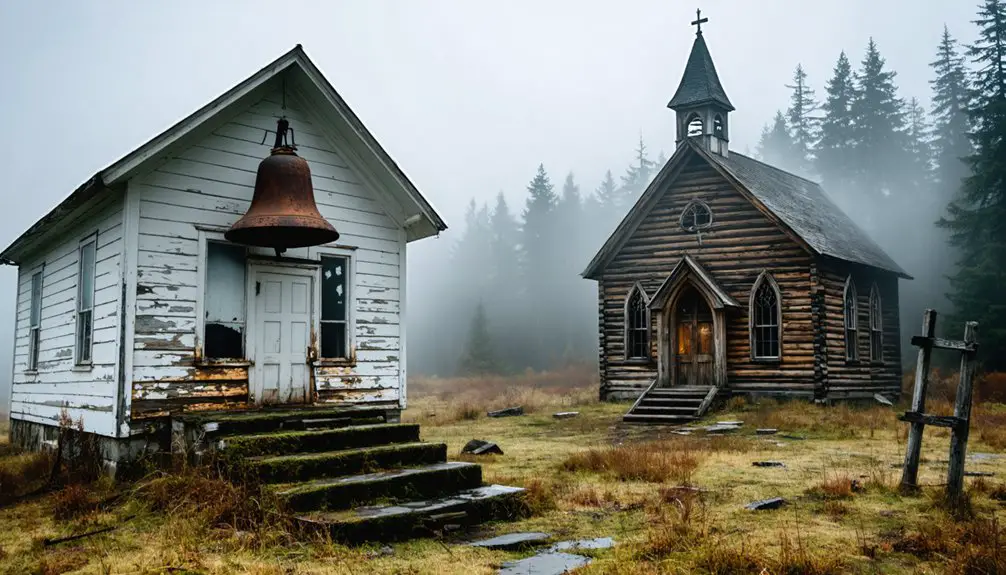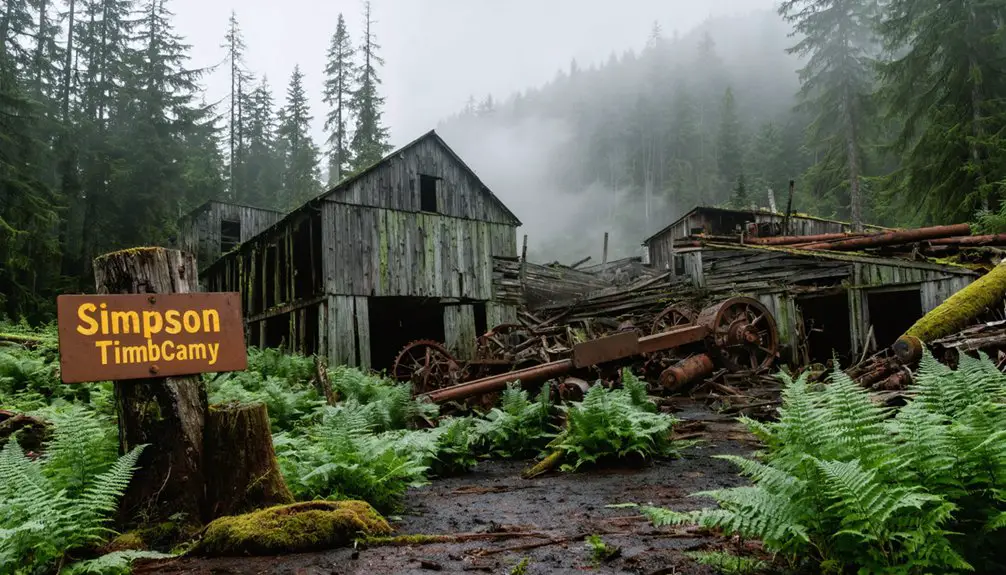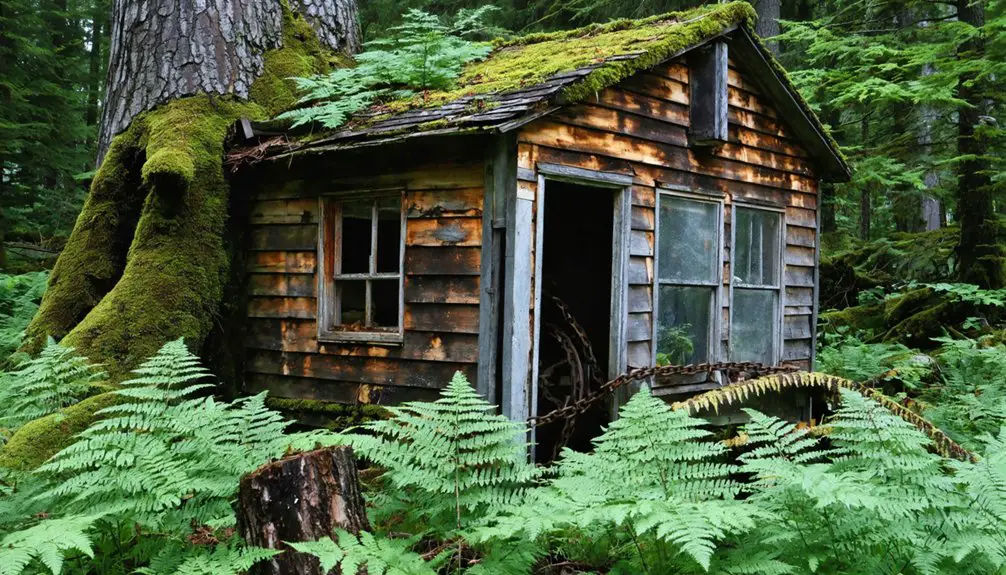You’ll find Camp Grisdale nestled in Washington’s timber country, where America’s last permanent logging camp operated from 1946 to 1986. Established by Simpson Timber Company, this innovative settlement featured 52 family homes, modern bunkhouses, a recreation hall, and a two-room schoolhouse – all rented for $20-30 monthly. While nature has reclaimed most structures since its 1988 demolition, scattered foundations and rusted mailboxes still whisper stories of this once-thriving logging community.
Key Takeaways
- Camp Grisdale operated from 1946-1986 as a logging settlement before being demolished in 1988, leaving only foundations and rusted remnants.
- The ghost town was the last traditional logging camp in the contiguous United States, attracting national media attention upon closure.
- Only scattered traces remain today, including old road forks, building foundations, and rusted mailboxes amid natural forest regrowth.
- The site formerly housed 52 family homes, bunkhouses, a recreation center, schoolhouse, and community store serving Simpson Timber Company workers.
- Located in Washington state’s timber country, the abandoned site now primarily serves as a forest access point for recreational activities.
The Birth of Camp Grisdale
In 1946, Simpson Timber Company established Camp Grisdale as one of the Pacific Northwest’s last major logging settlements, marking a significant shift from temporary camps to permanent communities.
Named after J. William and George M. Grisdale, nephews of founder Sol G. Simpson, the camp revolutionized logging techniques in the Olympic Peninsula’s challenging high country terrain.
You’ll find that Camp Grisdale wasn’t just another numbered logging station – it emerged as a thoughtfully designed community with fixed buildings near the Wynoochee Dam. The camp’s innovative design included daily housekeeping service in the bunk houses, setting a new standard for worker accommodations.
The camp’s community dynamics centered around its role as a crucial transfer hub, where logs harvested from steep slopes were moved from trucks to trains bound for Shelton’s sawmills.
This strategic location and permanent infrastructure made Grisdale unique among the region’s logging operations, setting new standards for sustained timber operations. At its peak, the thriving community housed 900 permanent residents, creating a stable workforce unlike the high turnover rates common in earlier logging camps.
Life in a Company-Owned Logging Town
While many logging camps of the era offered bare-bones accommodations, Camp Grisdale stood apart as a carefully planned company town that prioritized both comfort and community.
You’d find up to 300 single men in well-equipped bunkhouses and 52 families in cozy homes with green trim, all part of Simpson Timber’s $1 million investment.
The camp’s innovative logging techniques tackled the Olympic foothills’ challenging terrain, while strong community dynamics flourished through shared spaces. You could bowl, watch movies, play cards, or dance at the recreation hall. Established in 1946, Camp Grisdale represented a significant modernization in logging camp standards.
Children attended the two-room schoolhouse, built forts in trees, and picked wild strawberries. The timber industry has remained second largest manufacturing sector in Washington state.
Despite the demanding work environment, the camp’s unique blend of modern amenities and small-town atmosphere created a tight-knit community where loggers and their families thrived together.
Family Housing and Community Design
Through careful urban planning, Simpson Timber created a distinctive family-oriented community with fifty-two company-owned homes renting for $20-30 monthly.
You’d find these fixed structures designed with uniformity in mind, featuring neat and attractive designs specifically meant to appeal to loggers’ wives and promote familial stability.
Unlike typical logging camps, Grisdale’s layout fostered community cohesion through thoughtfully placed amenities.
You’d discover a two-classroom schoolhouse that doubled as a Sunday church, and a recreation hall equipped with bowling, billiards, and a movie theater.
The company store provided essential goods, while the homes boasted modern conveniences like hot and cold running water.
This carefully planned environment stood apart from traditional logging camps, reflecting Simpson Timber’s commitment to creating a permanent, sustainable community where workers’ families could thrive.
As the first planned community for lumberjacks in the United States, Grisdale set a new standard for logging camp development.
The town remained a vibrant logging community until operations ceased in 1985, after which nature slowly reclaimed the once-bustling settlement.
The Bunkhouse Experience
The bunkhouse system at Camp Grisdale accommodated nearly 300 single men in fixed dormitory-style lodgings, offering a stark contrast to the family homes nearby.
You’d find modern amenities unusual for logging camps of that era, including hot and cold running water. Each day, a dedicated bed maker would fluff your pillow and change your sheets on the thick mattress.
The bunkhouse camaraderie created a unique logging lifestyle, where you’d share your temporary home with fellow loggers near the trucking and rail transfer stations. Residents could make calls through the shared phone system that connected the entire camp.
Unlike typical mobile camps, these permanent structures served as your home base until the logging operations moved on, similar to how Almota’s residents were displaced when their town was submerged.
While the accommodations were basic, you’d have access to entertainment at the recreation hall, where bowling and movies offered relief from long workdays.
Recreation and Social Activities
The Frisken Recreation Center served as the heart of Grisdale’s social life, offering you bowling alleys, a movie theater, billiards, and card tables to combat the isolation of logging camp life.
You’d find the recreation hall bustling with regular community events, from school plays and concerts to performances by the local Grisdale Syncopaters jazz band. Much like the historic five saloons of Granite, these venues provided essential gathering spaces for the community.
The Grisdale Recreation Association kept spirits high by organizing movies, sports events, holiday programs, and dances that drew both residents and visitors to this remote mountain community.
Entertainment Facilities and Programs
Located within the heart of Grisdale, a bustling recreation hall served as the town’s primary entertainment hub, featuring two bowling lanes, a small movie theater, billiards tables, and a spacious dance floor.
You’d find the hall consistently alive with community gatherings, from school plays and concerts to social dances that brought residents together.
The town’s social structure carefully balanced family life and single workers’ entertainment, with separate recreational spaces for each group.
While single men enjoyed their own cookhouse and bunkhouse area, families had access to outdoor spaces and a company store for their leisure needs.
Despite limited radio and TV options, you’d discover plenty of entertainment through hunting, fishing, and regular community events that defined Grisdale’s vibrant social scene.
Community Social Events
Whether you were a logger, family member, or visitor to Grisdale, you’d find a rich tapestry of social activities woven into daily life.
The recreation hall buzzed with community traditions, from lively dances to movie nights, while the bowling alley and billiards tables drew crowds for friendly competition and social bonding.
You’d encounter families gathering for Sunday church services in the two-classroom schoolhouse, which served as both an educational center and spiritual hub.
The great outdoors beckoned with hunting and fishing opportunities, as deer, elk, and black bears roamed nearby.
The Simpson Timber Company provided these amenities to create a comfortable environment for their logging workforce.
The company store and cookhouse weren’t just places for supplies and meals – they’re where you’d swap stories and forge friendships.
Even the separated living areas for singles and families created their own unique social dynamics.
Recreation Hall Activities
Inside Grisdale’s bustling recreation hall, you’d find two bowling alleys, a movie theater, billiards tables, and a spacious dance floor that served as the heart of community entertainment from 1946 to 1985.
The recreation hall fostered community bonding through regular events coordinated by the volunteer-run Recreation Association.
- Evening movies played systematically, offering entertainment to both single loggers and families who’d gather to escape the region’s notorious rainfall.
- The famous “Grisdale Syncopaters” jazz band performed at dances, drawing visitors from neighboring communities.
- School plays, Christmas programs, and concerts took place on the hall’s stage, showcasing local talent and strengthening community ties.
These amenities were rare luxuries for a logging camp, making Grisdale a model for worker welfare and social cohesion.
Education and Religious Services

At the heart of Grisdale’s educational system stood a two-classroom schoolhouse where Lou Messmer served multiple roles as teacher, principal, bus driver, and janitor for eight grades of students.
You’d find the same building transformed on Sundays into the camp’s spiritual center, where weekly church services brought the logging community together in worship.
The schoolhouse, along with the company store and recreation hall, formed the core of community life for the 52 families and hundreds of loggers who called this remote timber camp home until its closure in 1985.
School Life and Structure
The two-classroom schoolhouse in Grisdale served as both an educational center and spiritual hub for the logging community, accommodating eight grades of students from the town’s 52 family homes.
Under the dedicated leadership of Lou Messmer, the school structure maintained high standards while adapting to the unique needs of a remote logging settlement.
The school’s community integration went beyond traditional education:
- Weekdays were devoted to teaching eight different grade levels across two classrooms.
- Sundays transformed the building into a church, providing essential spiritual services.
- The facility served as a cornerstone of stability, helping retain workers’ families by offering their children consistent education.
You’ll find it remarkable how this simple schoolhouse became the foundation for sustaining family life in Grisdale’s logging community.
Religious Community Gatherings
Religious life in Grisdale centered around Sunday services held in the two-classroom schoolhouse, demonstrating the resourceful nature of this logging community. You’d find both families from the 50 homes and single men from the bunkhouses gathering weekly, strengthening community bonds through shared spiritual gatherings.
With no dedicated church building, the camp made efficient use of its limited infrastructure. The school’s transformation into a worship space on Sundays reflected a common practice in company towns of that era.
George Lincoln Drake’s vision for a stable family environment supported these religious observances, while the recreation hall complemented spiritual life with social activities. The integration of education and worship spaces helped maintain regular attendance and fostered a sense of belonging among Grisdale’s isolated residents.
Daily Operations and Timber Transport
During its four-decade operation from 1946 to 1986, Camp Grisdale served as Simpson Timber Company’s primary timber transfer hub, where logs harvested from the South Olympics’ challenging terrain converged.
The camp’s timber logistics involved specialized handling techniques adapted to high-country conditions, with trucks bringing logs from steep hillsides to the railhead for transfer onto flatbed cars bound for Shelton’s sawmills.
- You’d find an extensive rail network with structural trestles on pilings called “bents” managing elevation changes.
- Mobile logging camps dotted the rail lines every few miles, though Grisdale stood unique with its permanent structures.
- The operational challenges of high elevation and steep slopes required innovative transport solutions, making Grisdale’s position as a transfer station essential to the region’s timber industry.
The Role of Simpson Timber Company

Simpson Timber Company’s influence on Grisdale began long before the camp’s establishment, starting with its strategic 1941 acquisition of McCleary’s holdings. This purchase expanded their workforce to 1,400 employees and secured essential timber resources in eastern Grays Harbor County.
You’ll find Simpson’s commitment to logging innovation and timber sustainability shaped Grisdale’s development. They created one of America’s first sustained yield forest programs in 1943, while their 1946 cooperative agreement with the U.S. Forest Service demonstrated forward-thinking resource management.
The company transformed logging practices, advancing from oxen to steam donkey engines, and developed specialized techniques for the challenging South Olympic terrain. Through Grisdale, Simpson created a model timber community, complete with family homes, a company store, and recreational facilities – all while pioneering sustainable forestry practices that continue through their successor, Green Diamond.
The Final Days and Closure
After operating for nearly four decades as America’s last company-owned logging camp, Grisdale’s final chapter began in 1982 when Simpson closed the bunkhouses and cookhouse.
In 1982, Grisdale’s era as the nation’s final company logging camp drew to a close, marking the end of a vanishing American tradition.
The camp’s final operations attracted significant media coverage, highlighting the end of an era in American logging history. By 1985, remaining families received relocation notices, and the full shutdown was completed by 1986.
- The camp’s closure garnered national attention as the last of its kind in the contiguous United States
- All buildings were demolished by 1988, returning the site to nature
- The only physical remnants you’ll find today are rusted mailboxes and some foundation traces
You can still trace the camp’s footprint through access roads, though the area has become overgrown woodland within Olympic National Forest.
Modern Day Site and Historical Impact
If you visit Grisdale’s former site today, you’ll find only foundations, old road forks, and a row of rusted mailboxes where a thriving logging community once stood.
The town’s strategic location in the Olympic foothills made it an essential hub for Simpson Timber Company’s operations, connecting remote timber harvests to the mills in Shelton through an innovative combination of truck and rail transport.
While the physical structures were demolished in 1988, Grisdale’s legacy lives on as a pioneering example of permanent company towns that prioritized family living and worker retention through affordable housing and extensive community amenities.
Current Site Condition
Today, Camp Grisdale stands as a shell of its former self, with virtually no remaining structures visible at what was once a bustling residential logging camp.
Since its closure in the mid-1980s, nature has steadily reclaimed the site, with forest vegetation covering most traces of the former settlement. You’ll find no formal site preservation efforts or visitor facilities, though you can still access the area via forest service roads.
- Active logging continues in the surrounding region, maintaining the area’s industrial forestry heritage
- Natural regrowth has obscured most physical remnants of the camp’s buildings and infrastructure
- Local recreational use focuses on general forest access rather than historical tourism
The site’s transformation reflects the broader pattern of abandoned logging camps throughout Washington, leaving behind only scattered traces of its industrial past.
Legacy For Logging Industry
Camp Grisdale’s enduring legacy extends far beyond its abandoned grounds, having shaped the evolution of Washington State’s logging industry during its 40-year operation from 1946 to 1986.
As the last logging camp in the continental U.S., it pioneered vital logging innovations, particularly in steep-terrain harvesting and efficient log transportation systems.
You’ll find its influence in modern timber practices, where Grisdale’s integrated approach to worker welfare and operational efficiency set industry standards.
The camp’s emphasis on family-friendly housing and community amenities revolutionized worker retention strategies.
Today, the logging industry remains Washington’s second-largest manufacturing sector, building upon techniques developed at Grisdale.
While the physical camp is gone, its cultural preservation continues through former residents’ stories, documenting a transformative era in Pacific Northwest logging history.
Frequently Asked Questions
What Was the Average Salary of Loggers Working at Camp Grisdale?
You’d have found logger wages at Camp Grisdale ranging from $1.50 to $3.00 hourly in the 1940s-50s, climbing to $4-$5 by the 1970s within the camp economy’s unique benefits structure.
Were There Any Major Accidents or Fatalities During Camp Grisdale’s Operation?
While specific accident reports and fatality statistics aren’t readily available, you’ll find documented deaths including Ralph Grisdale’s 1915 machinery incident and Joseph Grisdale’s 1931 shooting death in nearby logging camps.
How Did Severe Weather Conditions Affect Logging Operations at Grisdale?
Like nature’s fury released, severe weather created significant logging challenges – you’d see constant mudslides, icy roads blocking transport, and flooded access routes that disrupted your daily timber operations and supply chains.
Did Native American Tribes Have Any Historical Connection to the Grisdale Area?
While Native tribes like the Sawamish and Skokomish had historical significance in the broader region, you’ll find no direct connection between indigenous peoples and Grisdale’s specific location in documented records.
What Wildlife Encounters Were Common Around Camp Grisdale?
You’d spot wild pigs rooting near trees, bear sightings were common around camp borders, and deer encounters happened regularly. Marine life like lingcod and wolf eels thrived in nearby waters.
References
- https://www.historylink.org/File/23208
- https://www.graysharbortalk.com/2018/12/24/remember-grisdale-the-finest-of-the-logging-camps/
- https://www.ghosttowns.com/states/wa/grisdale.html
- https://en.wikipedia.org/wiki/List_of_ghost_towns_in_Washington
- https://washingtonstate.fandom.com/wiki/Grisdale
- https://grisdalefamily.wordpress.com/2012/12/22/a-fir-logging-family-in-washington-state/
- http://www.rustygrapple.com/Logging-History.html
- https://www.wfpa.org/news-resources/blog/americas-last-logging-camp-still-has-an-impact/
- https://www.youtube.com/watch?v=tWvH237F1KU
- https://landingaday.wordpress.com/tag/grisdale-wa/



